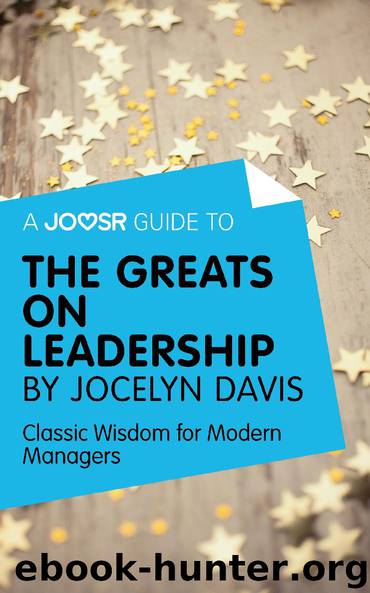The Greats on Leadership by Jocelyn Davis

Author:Jocelyn Davis
Language: eng
Format: epub
Publisher: Joosr Ltd
As a leader, you can create a positive climate by, first, understanding the elements that compose it, and, second, developing these elements through your own day-to-day actions.
A positive workplace climate helps employees to find greater meaning in their work. Greater meaning leads to higher levels of motivation, and higher motivation leads to higher achievement. Leaders who ignore this are ignoring the opportunity to fully unlock their team’s potential.
Master your professional relationships by categorizing them accordingly
A good leader needs to be able to manage their relationships with others well. Yet one key pitfall is the tendency people have to mis-categorize their professional relationships.
Often in life, we think that the people we know can be split into one of two categories: friend or foe. But to be an effective leader, it’s much better to place your relationships into four categories: friends, foes, allies, and adversaries. This will allow you to take a clearer-eyed view of the motivations of the people around you.
Put simply: A friend is unconditionally for you; a foe is unconditionally against you; an ally is conditionally for you; and an adversary is conditionally against you. Nineteenth-century French novelist Guy De Maupassant highlights this perfectly in his short story “Boule De Suit.” It tells the tale of a courtesan, Butterball, who is befriended and then cruelly dropped by a group of upper-class people who use her to gain an advantage in a difficult situation. Butterball makes the mistake of confusing temporary allies for friends.
You must avoid making similar mistakes. Leaders understand that workplace relationships are filled with as many opportunities as pitfalls, and they take a strategic attitude to their professional relationships. This is not the same thing as being manipulative; learning the art of politics is crucial to leadership success.
Just as it is dangerous to mistake an ally for a friend (not realizing that their loyalty and support is conditional upon it benefitting them), so is it also a missed opportunity to mistake an adversary for a foe, for an adversary can be swayed to support your case if you give them good enough reason.
Try this: Make a list of your key workplace relationships. Divide them into the categories of friend, ally, adversary, and foe (hopefully there are not too many of the latter!). Now choose an adversary and ask yourself how you could make them an ally—what benefits could you offer them? How could you more closely align your interests? By understanding the difference between friend and ally, foe and adversary, you will be able to avoid troublesome situations, and take better advantage of others.
To be a good leader, you need to become aware of the categories your relationships fall into. Form a habit of regularly evaluating these relationships, and develop strategies for creating and maintaining mutually beneficial ones.
Download
This site does not store any files on its server. We only index and link to content provided by other sites. Please contact the content providers to delete copyright contents if any and email us, we'll remove relevant links or contents immediately.
Hit Refresh by Satya Nadella(9036)
The Compound Effect by Darren Hardy(8806)
Change Your Questions, Change Your Life by Marilee Adams(7633)
Nudge - Improving Decisions about Health, Wealth, and Happiness by Thaler Sunstein(7613)
The Black Swan by Nassim Nicholas Taleb(7010)
Deep Work by Cal Newport(6877)
Daring Greatly by Brene Brown(6443)
Rich Dad Poor Dad by Robert T. Kiyosaki(6398)
Principles: Life and Work by Ray Dalio(6202)
Man-made Catastrophes and Risk Information Concealment by Dmitry Chernov & Didier Sornette(5921)
Playing to Win_ How Strategy Really Works by A.G. Lafley & Roger L. Martin(5911)
Digital Minimalism by Cal Newport;(5661)
Big Magic: Creative Living Beyond Fear by Elizabeth Gilbert(5610)
The Myth of the Strong Leader by Archie Brown(5421)
The Slight Edge by Jeff Olson(5346)
Discipline Equals Freedom by Jocko Willink(5279)
The Motivation Myth by Jeff Haden(5155)
Stone's Rules by Roger Stone(5026)
The Laws of Human Nature by Robert Greene(4996)
